What is Sustainable Travel?
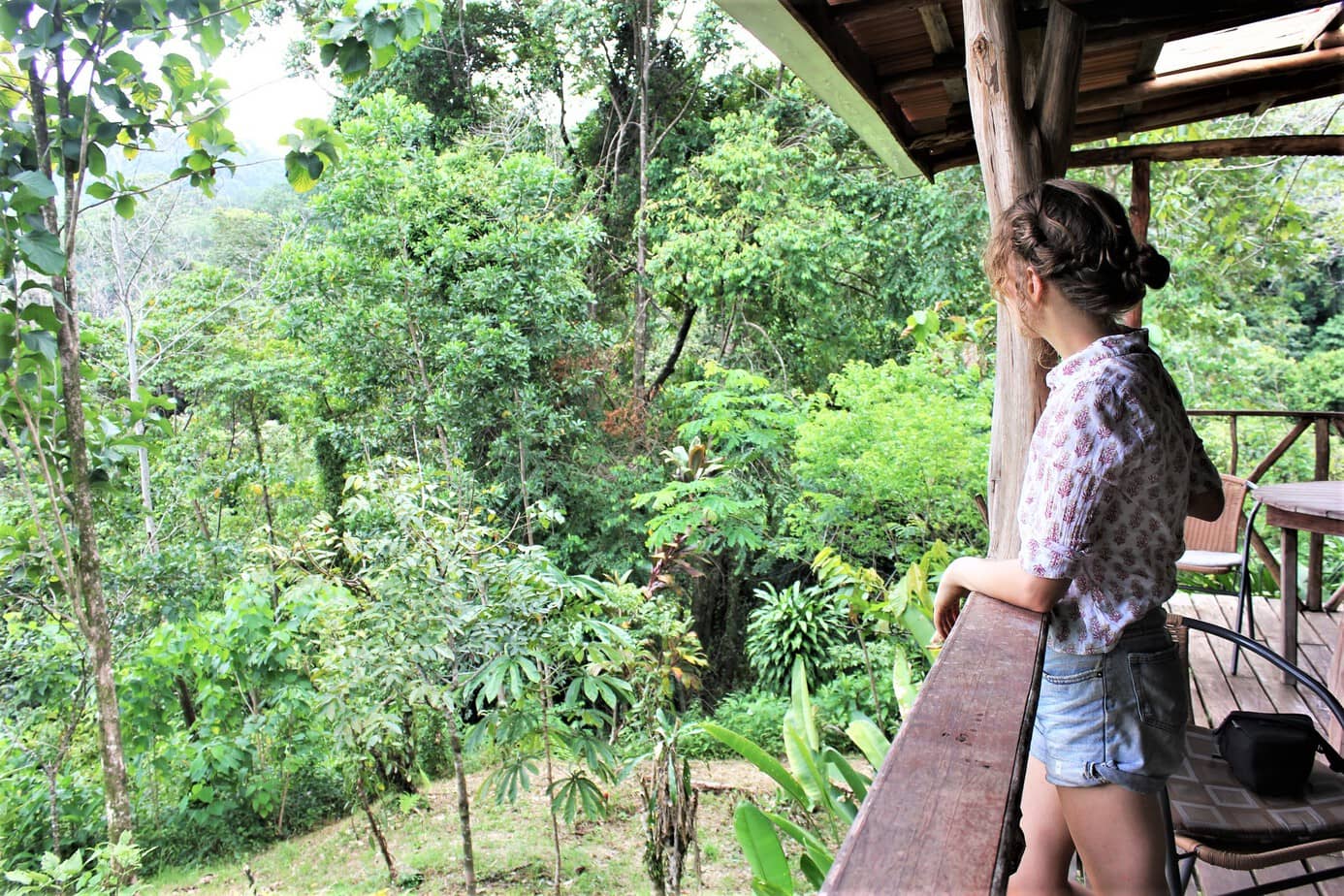
Sustainable travel should be the only way we travel. From excessive air travel that causes harmful CO2 emissions to package holiday resorts that are built on natural areas, international travel and tourism are far from sustainable.
Our world has finite resources. There are only so many beautiful, natural, untouched places on our planet and mass tourism threatens their existence. Nature, culture and history should be preserved, not commodified.
Unfortunately, many travellers and travel industry operators remain in denial about how limited our world’s resources are and how tourism is negatively affecting the environment, local cultures and communities. That’s where sustainable travel comes in.
What is Sustainable Travel?
Sustainable travel means finding a way that tourism can be maintained long-term without harming natural and cultural environments. Sustainable travel should minimise the negative impacts of tourism and ideally be beneficial to the area in which it takes place.
The World Tourism Organization defines sustainable tourism as “development [which] meets the needs of present tourists and host regions while protecting and enhancing opportunity for the future. It is envisaged as leading to management of all resources in such a way that economic, social, and aesthetic needs can be fulfilled while maintaining cultural integrity, essential ecological processes, biological diversity, and life support system.”
Sustainable travel is about valuing the environment, looking after our natural resources and respecting local communities and cultures. As travellers, we need to be more aware of pollution levels caused by travel and how that affects the environment and local wildlife. Social awareness a part of sustainable travel too and as travellers we also need to be mindful of how tourism affects local people, businesses and native cultures.
There is crossover in definition between sustainable travel, responsible travel, eco tourism and green travel. These terms encompass the idea of being more conscious of how we travel. They seek to minimise negative impacts on the environment and aim to have a positive impact for local communities and economies.

The Three Pillars of Sustainability
The concept of sustainability has three key principles, which are know as the Three Pillars of Sustainability.
The Environmental Pillar – The environmental pillar focuses on reducing negative impacts on the environment and wildlife from travelling. This includes minimising our carbon footprint, especially from air travel, water usage, packaging and plastic waste, and not disturbing wildlife. As sustainable travellers, we can have a simple positive effect by carrying our own reusables. We can look for hotels and restaurants which recycle and are built from sustainable materials. We can research wildlife tourism to seek out responsible tour operators.
The Social Pillar – The social pillar is about our impact on local people and communities. This includes supporting businesses that are run by, employ and support local people, as well as community tourism projects, NGOs, social enterprises and charities. Responsible travellers can look for opportunities to be involved in these types of projects and be aware of who businesses employ, whether they’re fairly paid and whether their work environment is safe.
The Economic Pillar – Traditionally, the economic pillar refers to businesses being profitable in order to be sustainable. However, when it comes to sustainable travel, we can apply the economic pillar to using our money to positively contribute to the local economy. As tourists, we can give our tourist pound to locally-run hotels, restaurants and tour guides to support the local economy.
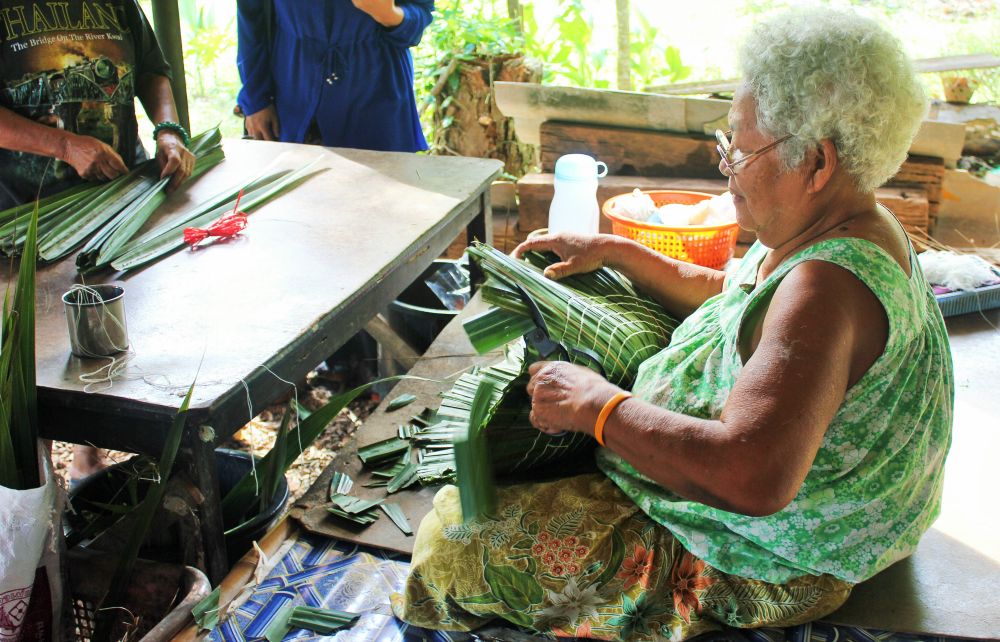
A local Thai woman cutting palm leaf hats, a traditional method in Thailand
Sustainable Travel and the Environmental Issues of Tourism
Tourism relies on burning fossil fuels, which contributes to climate change. It’s predicted that 40% of the world’s carbon emissions will be generated by tourism by 2050. To break this down, right now 72% of tourism’s CO2 emissions come from transportation, a further 24% from accommodation, and 4% from tourism activities. The environmental issues caused by tourism cannot be overlooked.
The problem is that while our environmental conscious tells us we should moderate how often and how far we fly, we rarely do. Many of us are ‘binge flying’ – that is flying far more often than is necessary just because we can. We have the time, the money and the desire to travel abroad. Some of us have an almost “insatiable” appetite for travel — and us digital nomads are particularly guilty here.
I’ve discussed whether air travel can really be sustainable and ways to mitigate the negative impacts of air transport before, but it’s important to remember that the choices we make when we’re at our chosen destination affect the environment too. Many destinations do not have regulations or strategies in place to cope with rapid development and overcapacity which is caused by increased tourism. Quite often foreign investors will come, build and leave chaos that the locals have to tidy up — including issues with waste, carbon and water.
As tourists, we should be mindful of how we travel and our impact when we arrive in a destination.
25 Ways To Be a Sustainable Traveller
As travellers and tourists, we need to take responsibility for advocating sustainable travel and tourism. This isn’t going to happen overnight. There isn’t a magical solution to solve the problems associated with tourism. But we can work towards better, more sustainable travel. Here are some tips for ways we can be more sustainable travellers:
Travel Style
1. Be respectful of locals and communities
When we travel, it’s important to remember that our holiday destinations are other people’s homes. They have to sleep, work and go about daily life. Be respectful of these communities, especially when staying in local neighbourhoods. Avoid being loud in the streets late at night, take your litter with you as you would do at home, and learn a little of the local language so you can greet others. In some cities, such as Barcelona, tourists are generally not well-liked not only for bad behaviour but because tourism has driven up rental prices in the city and pushed out many locals who can’t afford to live there. Research your destination ahead of time so you can make sustainable, mindful choices about where to stay.
2. Be a slow traveller
Mitigate the negative impact of air travel by flying less often and staying for longer in destinations. Beyond reducing your carbon emissions, being a slow traveller has many benefits and helps you to travel more sustainably including better integrating with the local community and understanding how tourism impacts them, and contributing to local economies for longer.
3. Research Sustainable Travel Destinations
Some travel destinations are more sustainable than others. Over-tourism is when there is a large influx of tourists to a destination that puts too much pressure on the environment and local communities living there. Venice and Machu Picchu are examples of destinations that struggle with over-tourism. Many places are tackling over-tourism issues head-on or putting preventative measures in place to ensure tourism is sustainable. Don’t miss these top sustainable destinations if you have the means to explore a destination which has a sustainable tourist infrastructure in place. If you do plan to travel to an area where over-tourism is a problem, try to travel off-season when footfall is lower.

Transport
4. Consider the most sustainable form of transport to get to your destination
Depending where you’re going, you may have the option to fly, drive or take a train or coach. Weigh up your options. If you’re travelling in a group, it makes sense to car share whereas if you’re travelling on your own it may be greener to fly or take the train. Taking the train or bus is often the more sustainable option over flying or driving by car, but it depends on the route.
5. Take direct flights where possible
Look for the shortest flight path to your destination. Take offs and landings cause most of a plane’s carbon emissions, so it’s best to take a direct flight and avoid changes or stop-overs where possible.
6. Fly economy class
Flying in business class or first class means you have more space per passenger. This can result in a 5x larger carbon footprint. Take the economy seat because it better for your budget and the environment.
7. Use the most sustainable form of transport when you’re at your destination
When you’ve arrived in your destination, go by foot or bike whenever possible. These are the greenest transport options. Use public transport, minibuses or car shares to get around instead of private cars when you’re going further.
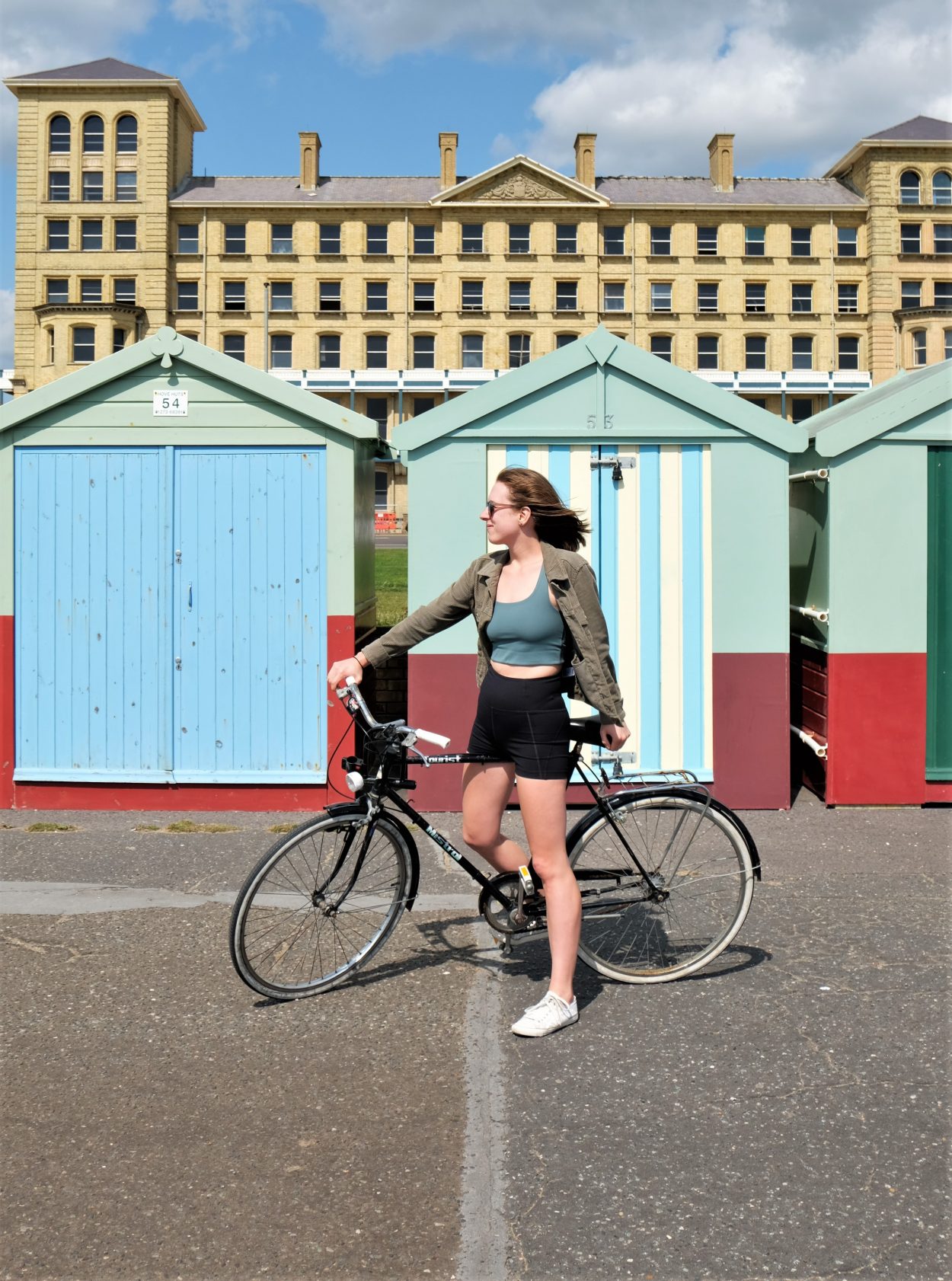
Accommodation
8. Stay in locally-owned accommodation
Support local business owners by opting to stay in locally-owned accommodation. This can include guesthouses, B&Bs, Couchsurfing and home stays. Read the ‘about’ pages on hotel websites and check out the host’s profiles to get a better idea of who owns and runs the accommodation. It’s more sustainable if your money contributes to the local economy, rather than being redirected out of the local economy by foreign-owned hotels and resorts.
9. Check for green certifications at hotels and hostels
Look for accommodation with a commitment to sustainability initiatives. These may include solar power, energy-efficient lighting, recycling and so on. Find out whether a hotel employs local staff, source their food locally and use locally sourced building materials and decor.
“Search for eco hotels which are designed and built sustainably,” says Amruta Kshemkalyani, a sustainability professional and founder of Sustainability Tribe. “There are standards and certifications for sustainable hotels and resorts like Green Globe and Green Key.” You can look for these certifications on hotel and hostel websites.
When we travelled in Costa Rica, we stayed in a number of eco-lodges that were built and operated in a sustainable way (our favourite was La Kukula!) Watch out for ‘green washing’ — unfortunately many hotels have labelled themselves green without actually putting sustainability initiatives in place.
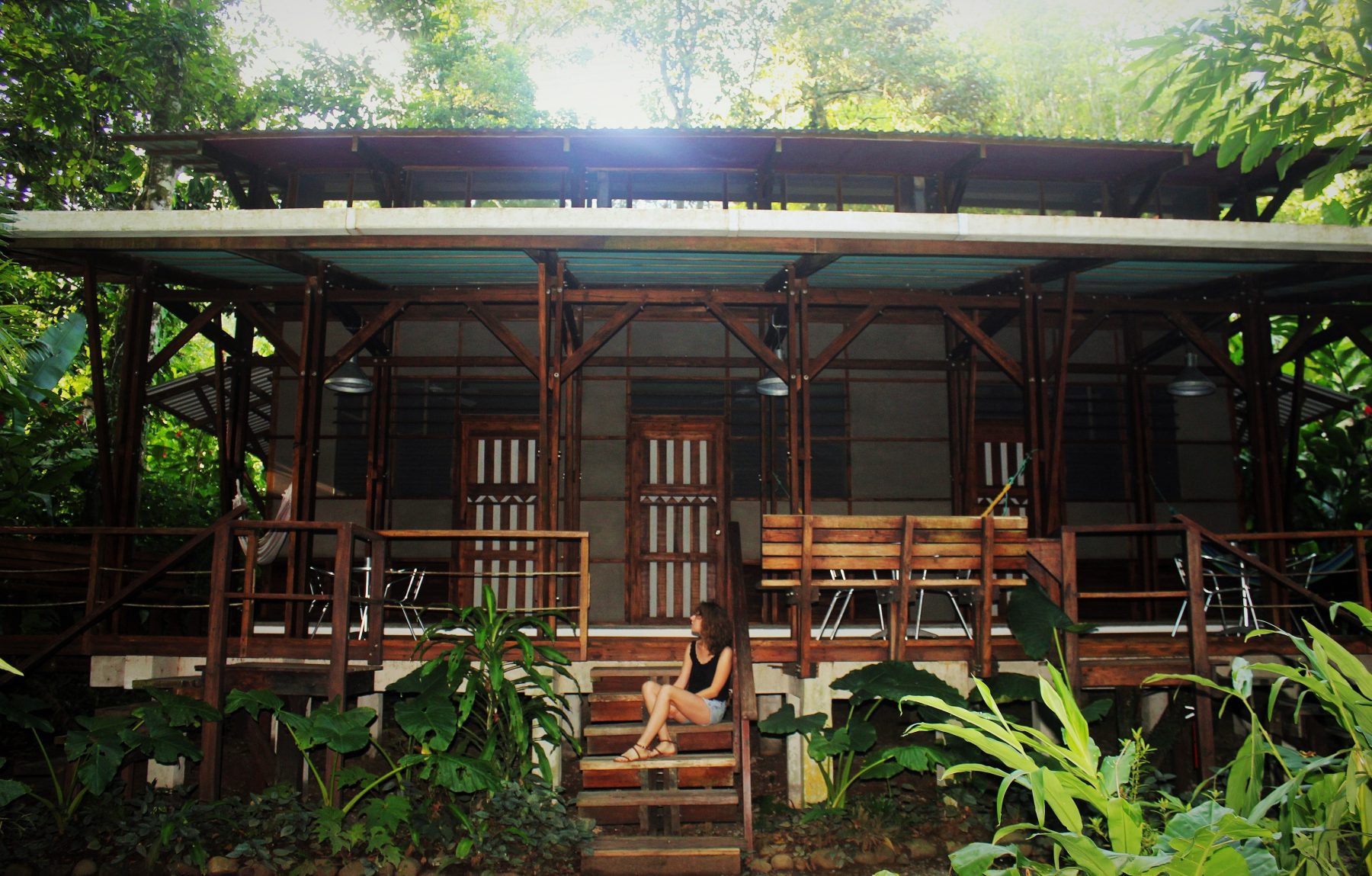
La Kukula eco-lodge in Costa Rica. One of our favourite places.
10. Avoid large resorts
Large resorts have negative impacts on the local environment due to their water and energy consumption. Washing towels and changing bed sheets daily are common in large resorts and waste energy and water. Many resorts also concrete over large areas of natural habitat to build guest rooms and swimming pools.
11. Avoid all-inclusives
All-inclusive package holidays often mean you pay up-front for your accommodation, food and activities. This means tourists have little incentive to go elsewhere and often do not go out to local restaurants, hire local tour guides or participate in cultural activities. Resort accommodation in all-inclusives tend to be foreign-owned and this means tourist money doesn’t benefit the local economy. All-inclusives tend to not be sustainable for these reasons. If you do prefer the ease of all-inclusive travel, look for locally-owned resorts and opt to go half-board or not to have activities included so you can enjoy supporting local businesses.
12. Go wild and camp
If you’re committed to sustainable travel accommodation and love the outdoors, then camping is a great option. Luke and I are not regular campers, but we’ve enjoyed camping spots across the UK like Dancing Ledge. There are many environmental benefits and camping areas tend to be less built-up and more integrated in nature. If you can wild camp, even better.

Luke looking proud of himself after putting this tent up.
Sustainable Tours, Activities & Volun-tourism
13. Use sustainable tour operators with green accreditations
Do your research before booking tours. Look for accreditations such as GSTC, Green Globe, Rainforest Alliance, EarthCheck, Green Tourism Business Scheme (UK) and other regulatory bodies.
Read reviews on third party websites such as Google, TripAdvisor and TrustPilot reviews. I often specifically read any negative reviews to check the concerns of other travellers.
Read reviews and blog posts from travel bloggers who you trust. If you can, get in touch with the tour company before hand to ask them about their policies if it’s unclear from their website.
14. Watch out for ‘green washing’ by tour operators
Green washing is when a company makes unsubstantiated claims about their green credentials to appear more environmentally friendly than it really is. How can you identify companies which might be green washing?
“Use external resources to help vet sustainable businesses and destinations,” advises Eytan Elterman, Chief Impact Officer at Lokal Travel. “Research whether the country has a certification process; for example Costa Rica has a system where they give sustainable businesses a rating, from 1 to 5 leaves. Colombia is also emerging as a country where the government is helping certify sustainable travel businesses.”
“There are also independent organisations that help this process, for example the Global Sustainable Tourism Council is a leader in providing a global standard for sustainable tourism,” add Eytan.
15. Only participate in responsible wildlife tourism
Avoid any wildlife tours that promise up-close encounters with animals, as these may be unethical. You can usually get a sense of whether an animal tourism activity may be unethical based on the interaction with the animals, especially if the animals are not used to human contact. If you’re allowed to touch, cuddle or ride the animals, this is a bad sign.
Look for tours that won’t disturb wildlife and that ensure you are a certain distance away from any animals. Do your research into each specific type of wildlife tourism to ensure it is responsible. I also recommend reading Responsible Travel’s article on wildlife tourism issues.

Semi-wild orangutans in Borneo. Orangutan tours support conservation efforts in Borneo.
16. Snorkel and scuba dive responsibly
If you’re snorkelling or scuba diving, be careful not to tread on the coral as this can damage the fragile ecosystem. 25% of coral reefs worldwide are now damaged beyond repair. If we want to preserve our beautiful reefs, we must snorkel and scuba dive responsibly. When you snorkel or dive, go with smaller groups to avoid overcrowding. Do not try to touch or feed fish or animals. Make sure to wear reef-friendly sunscreen. Many supermarket shelf sunscreens contain titanium dioxide. This mineral does not biodegrade and it reacts in warm seawater to form hydrogen peroxide which is harmful to all sea life.
17. Volunteer with NGOs and Join Community Tourism Projects
Take opportunities to involve yourself in projects with NGOs and community tourism organisations. These may be volunteering opportunities or a chance to learn about local life and practices. Always research volunteering opportunities and the organisers behind them to ensure that your time and money will be positively contributing to the place and/or people you are visiting. We’ve had great experiences with Local Alike in Thailand and De La Gente in Guatemala. It’s worth noting that not all volunteering opportunities do contribute positively, so be sure to have researched this thoroughly.
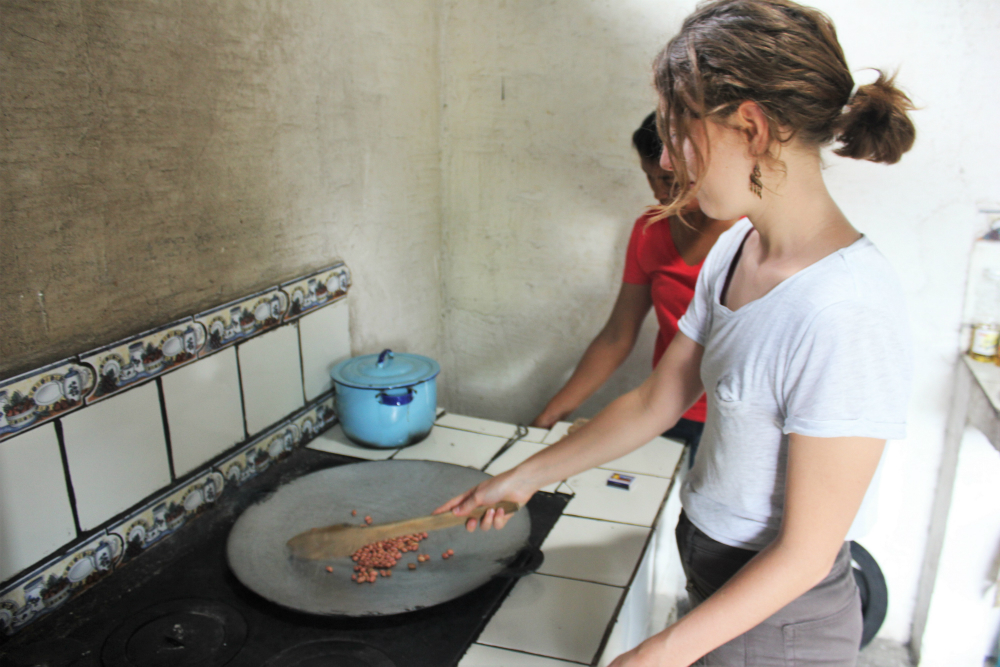
Me learning to make peanut butter from scratch with De La Gente
Local Environment
18. Eat in restaurants and cafes owned by locals
As with accommodation, spend your tourist dollar in restaurants and cafes run by locals. In our experience, this is a great way to meet locals who are enthusiastic about you trying their traditional food. Not to mention that home-cooking is the best, so if you can find small hole in the wall places or join sharing economy apps like EatWith where you can have dinner with a local family, you’ll most likely be eating more delicious food too. Avoid international food chains like McDonald’s where your money doesn’t enter the local economy.
- Me eating a plato tipico in Soda Angel, our favourite locally-run food place in Costa Rica
- Luke refilling his horchata (rice drink) at a local farmer’s food market in Guatemala
19. Eat local cuisine
Eating local cuisine often means a lower carbon footprint as food is often locally grown or imported from nearby countries. It’s also a cultural experience that helps you connect with a community and their culture. “Eat local cuisine, made from locally sourced ingredients,” says Guillermo Jaques, founder of Barcelona Slow Travel. “And if it’s organic, and comes from small farmers, even better!”
20. Don’t be (too) afraid of eating local street food
Street food vendors are often locals cooking up their own homemade dishes. We’ve eaten some of our favourite dishes abroad from street food carts. Be careful of anywhere that looks unsanitary, as you don’t want to get food poisoning.
21. Buy locally grown food and shop in local markets
Eat locally grown food from local producers. Avoid imported foods and international food chains where food has had to be transported from far away causing carbon emissions. You can shop for local fruits, vegetables and other produce at local farmers markets. The farmers markets were one of our favourite places to go in Costa Rica.

Sustainable Shopping
22. Buy gifts made by local artisans
Buy locally made gifts to take home as souvenirs. Avoid imported souvenirs that will have been flown or shipped in and therefore have a larger carbon footprint. It’s better to take home souvenirs unique to the country where you’re travelling, rather than something from a factory elsewhere.
23. Have a ‘one in, one out’ rule for buying clothes
I have a personal ‘one in, one out’ rule for clothes. I’ll wear my clothes until they’ve got holes and become unwearable, then swap out for a new item of clothing. This way, I avoid buying unnecessary clothing or participating in the fast fashion industry. If you can, buy higher quality and more durable fabrics which last longer. Shop sustainably and consider who made your clothes too. It’s better if you can source clothing made on an ethical production line where workers are safe and paid a fair wage.
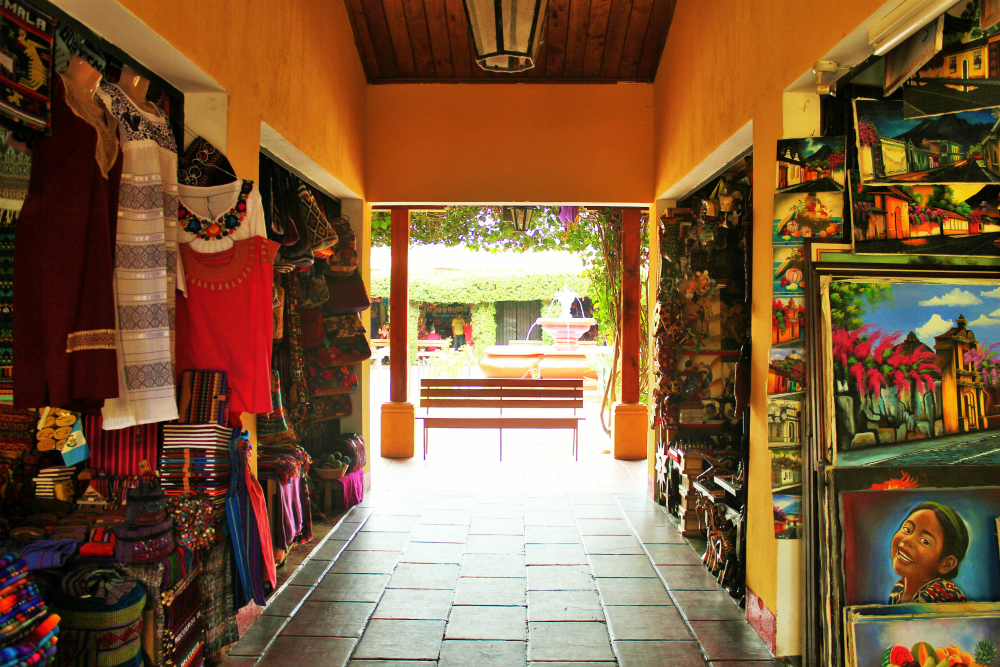
Walking through the Artisan Market in Antigua, Guatemala
Sustainable Travel Packing
24. Pack light
“Travel light, your luggage adds up to the carbon emissions,” says Amruta of Sustainability Tribe. A plane’s fuel consumption is greater if the weight its carrying is heavier. Need some help with this one? Here’s how to pack light.
25. Pack eco-friendly essentials
Packing a reusable water bottle, reusable bag and a lunch box will mean you can cut down on plastic waste when you travel. I also opt for toiletries such as shampoo bars, a natural deodorant block and a mooncup that come in paper packaging rather than plastic and last longer. My eco-friendly travel packing list has my full kit.
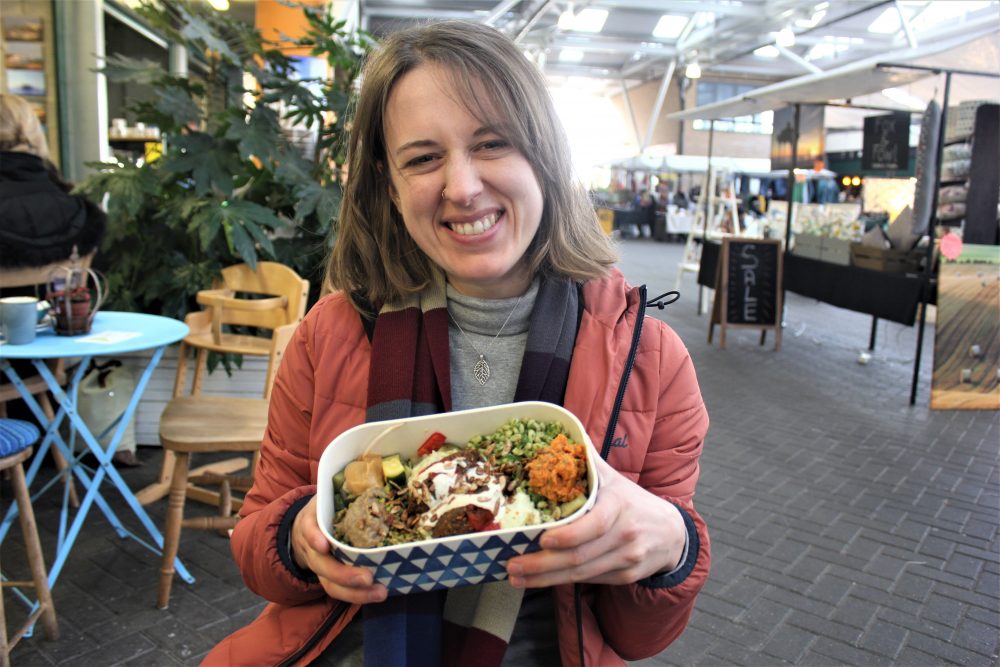
Me with my reusable lunch box
Speak Up for Sustainable Travel
26. Ask for more sustainable travel!
The responsibility of finding a more sustainable model of tourism doesn’t only fall with the traveller, but with the airlines, host countries, local governments, and business owners. Many of them realise that they need to work more on sustainable tourism initiatives but are concerned about upsetting the status quo by putting restrictions or taxes in place to mitigate the negative impacts of mass tourism. Speak up and let businesses know that you’re interested in sustainable travel and want to know their sustainability initiatives and goals.
27. Share your sustainable travel experiences!
Share your responsible travel experiences with friends, family, people you meet, on social media and I’d love to hear about them in my comments section below! The more we talk about the way we travel, the more we reinforce how important it is to travel green.
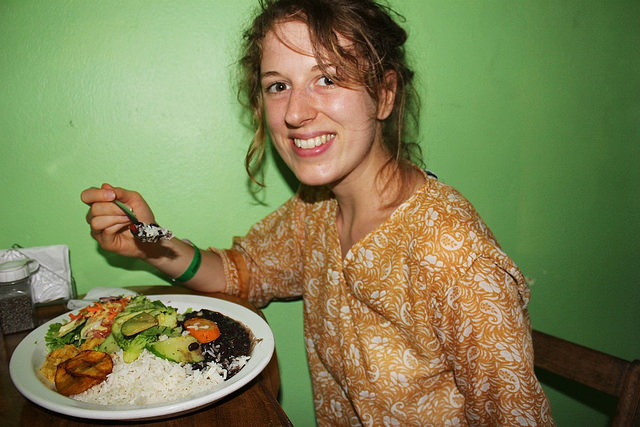
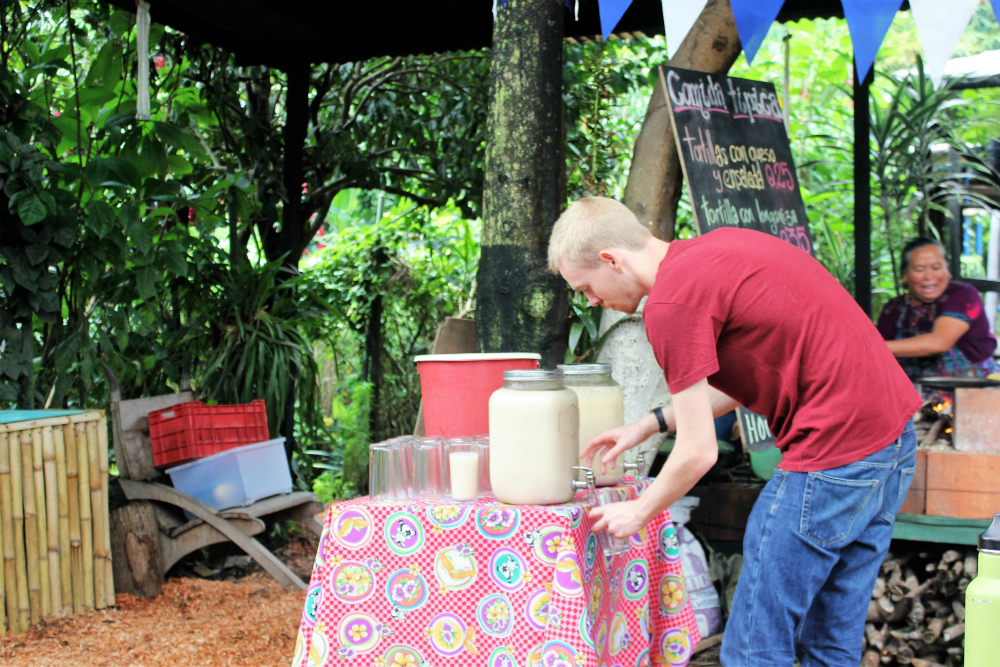





Duke Stewart
Charlie,
I really loved the message and direction you went with this post. Distinguishing sustainable travel from responsible and green is a pretty important and difficult task and I think you did well to focus on just the one. The message would get muddied otherwise. I’m a bit guilty of opting for a flight over other means when time was the biggest factor. I’d like to chime in and nominate local travel as another method of sustainable travel. We don’t necessarily have to leave our own countries or even cities to get out there. As our carbon footprint gets bigger and bigger, that’s definitely something to think about. Regardless, thank you for bringing up this important topic and for writing in such a poignant manner on it. Cheers.
Charlie on Travel
Hey Duke, thanks for reading and sharing your thoughts. Differentiating all of those terms is quite a challenge because there are so many overlaps and because the tend to be used interchangeably due to their similarities – but I do think that there are some distinctions to be made. I totally agree with local travel as being an excellent method of sustainable travel, great shout! Really appreciate you taking the time to comment :)
Jing
Hi Charlie! You are right to say that sustainable tourism involves the concerted effort of all players in the tourism industry. Tourism involves a chain of activities, and unfortunately, most of these activities can have negative impacts on the environment.
My work is in the field of environmental management and incidentally, I also love to travel. As a traveler, I wanted to infuse the environmental management principles I use at work, in my way of travel. I myself admit that it is not always easy to practice sustainable travel. In choosing hotels, for instance, I’m guilty of choosing only based on cost and online reviews. And these reviews often lack the criteria on social and environmental sustainability.
There are much more that needs to be done, but I want to take it positively that it can be done. Being sustainable is a process and as you said, it’s not just the traveler’s responsibility alone. It’s best to start with what we control, meaning us, as travelers.
Thank you for putting this information together and I hope more and more travelers will be more conscious about responsible travel.
Aaron Salyer
Hi Charlie,
Love this post.
Covers all the essentials!
Great photo of the local food too. What a plate. Must have been hungry.
Have seen the term greenwashing around a bit lately. It’s a bit sad. As the push for more eco and sustainable options become more popular, there are a lot of companies jumping on board!
Think it really is up to us as consumers to choose smarter!
Charlie Marchant
Hi Aaron, thanks for your comment. Love your blog too! Yes, I agree, it treats green travel as though it’s a trend that’s in fashion and misses the core concept that sustainable travel needs to be the only way that we travel. I think it has to come down to consumers choosing smarter too, spending their money with companies that are green and sustainable and showing there’s a demand for greener travel. The more that happens, the more we will force un-sustainable companies to rethink their products.
Fiona & Russell
Hey Charlie,
Really great approach and thank you for sharing. Your blog has really inspired us to start making more conscious efforts while travelling. We have linked to your site for helpful resources for our readers. Unfortunately, carbon emissions seem to be the biggest contributor so we will similarly work towards slow travel.
As well as greenwashing from businesses, there seems to be a debate about greenwashing from bloggers/influencers too. What are your thoughts on this?
Thanks again, we love your blog.
Charlie Marchant
Hey Fiona and Russell,
Thanks for your kind message and sharing your thoughts. Carbon emissions is a big one and a difficult issue when legislation really needs to be coming from higher up the chain rather than solely relying on individuals. Pressure from individuals is what we need to see that change start to happen though.
It’s an interesting debate and one I think people need to be careful around. There’s a distinction to be made between ‘green washing’ (trying to deceive a consumer about how environmentally-friendly something is for financial gain) and ‘trying to be green’ (those doing their best to make a positive environmental impact and mitigate negative impacts, educate others etc even if they are not 100% green). I personally mostly consider bloggers to fall into this second category because there’s really a lot less financial gain to be made in blogging by perusing eco/green content over broader industry content. I’m sure there are exceptions, though I don’t know of any personally, although there is a point to be made around the promotion of ‘consumerism’ even around eco products. Businesses on the other hand may tend towards intentionally green washing in order to make a larger financial gain – the debate going on with H&M and other fast fashion high street retailers being a current example of this. Large chain hotels often fall into the same category here by trying to promote insignificant sustainability initiatives (e.g. no plastic straws) whilst being huge contributors to environmental problems (mass laundry, pumping air con, concreting jungles etc).
Aakansha
I have drawn a ton of inspiration from this blog post. Found myself smiling most of the times because without even realizing I was taking conscious steps.
Thank you for such an informative blog post. I am grateful to you for your contribution.
This blog is genuinely what the world needs to draw value from.
God bless you!
Love & Light,
Aakansha from themavenlifestyle.com
Charlie Marchant
Hi Aakansha – That’s wonderful to hear and thanks for reading. It’s always great to hear from others who are on their own conscious journey!
Ashley
Disagree about all inclusives not being sustainable – if anything it’s the big guys who are supporting the local economy and sourcing for food from nearby markets etc in addition to providing jobs for locals who in turn can support their family and community. I think it’s egregious to just be dismissive of all inclusive places – especially in places where food in the local area may not meet hygiene standards you’d find in a resort.
Charlie Marchant
Hi Ashley – thanks for sharing your point of view on this one. You’re right that all inclusives often do employ locals and if they’re paying them a fair wage then that’s great. Unfortunately many employers aren’t transparent about this. However, environmentally all-inclusives tend to be much worse than local guesthouses or bnbs, and their profits are often also farmed out of the country and don’t contribute to the local economy whereas with locally-owned guesthouses that money goes direct to locals. As for food hygiene standards, I think this really depends and I certainly haven’t always found it the case. Many local restaurants and guesthouses have high hygiene standards and are not making food at such large scale as the resorts.
Claire
A very useful and informative post! So many key points to take away from this :)
Chelsea Paschall
Charlie,
Thank you for sharing your tips for traveling with heightened awareness!
It has often been brought up to me, the contradiction of terms in being ‘an environmentalist who likes to travel’. As another commenter mentioned, local travel is a way to travel sustainably, and I acknowledge that unique cultures can be found locally. However, I don’t know that it can equate to the illuminating exchanges of culture that can be made when people travel internationally.
In the best case scenarios, when it is done respectfully and as sustainably as possible, mutually beneficial relationships can be established with transformative impacts.
To that point, many unsustainable products have been introduced to the countries that so many of us love to go to because they are less ‘developed’. However, they also tend to have poor waste disposal infrastructure. To be fair, many developed nations, including where I reside, the United States, often do not have progressive waste systems. *In my dream world BPI certified compostable or hemp products will have replaced all plastic and polystyrene products*.
Given that we are still in a reality of dominant petroleum products…while it is certainly proactive for travelers to carry their own reusable containers…what can we do to spread the use of plastic-free reusables?
While traveling in Peru, I found a four-pack of metal straws and celebrated that I could now drink coconuts without spilling half of it down my chin (because I refused to contribute to the plastic straws that would so often litter the beaches), and I was able to give the other three away, but that wasn’t enough to match the interest I encountered, this also occurred with my clip-on metal cup, many people wanted one at Carnival in Brazil. I’m curious if you or anyone else reading your post, has had success making sustainable products available in other countries…in a way that benefits the country and not just the business and/or partnering with a sustainable producer in other countries to make their products more available in your home country?